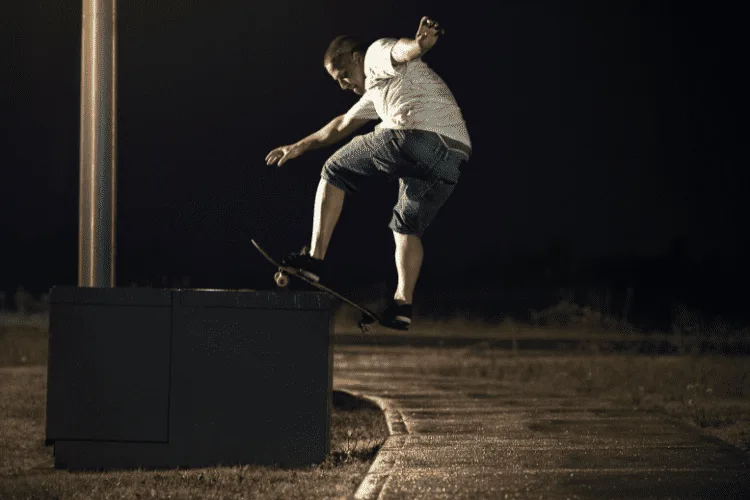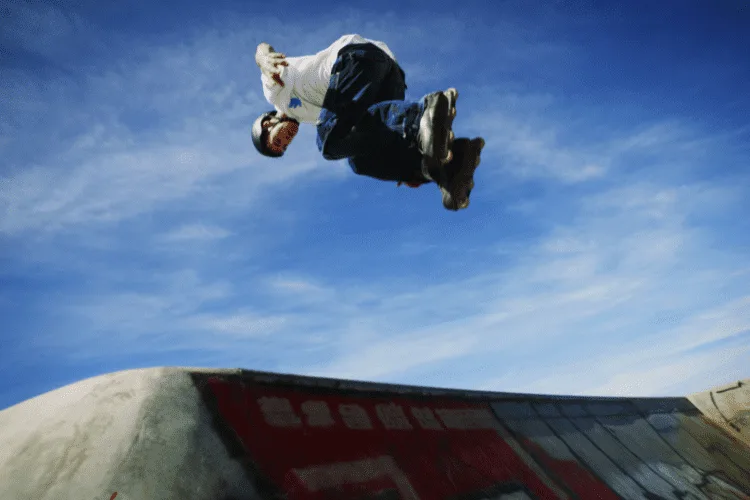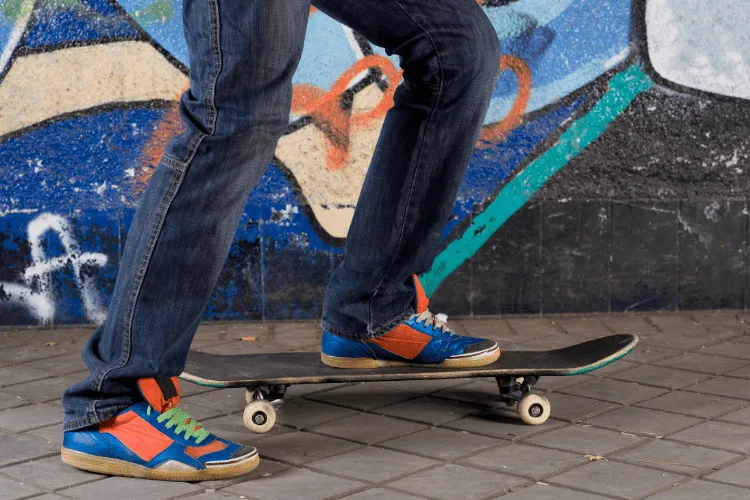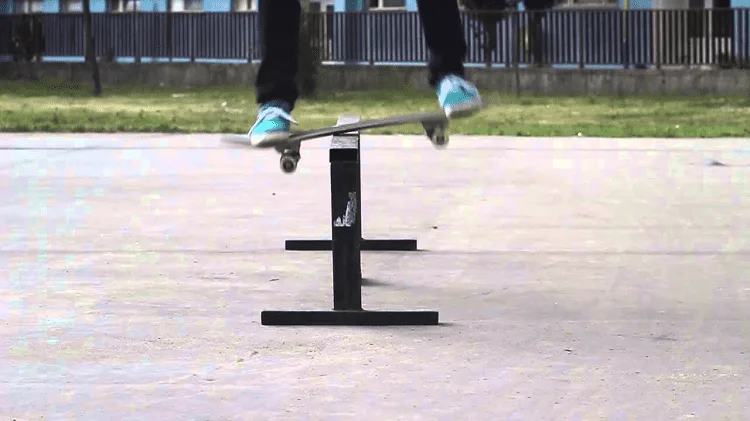- DGK Viper 8.125 Deck Review: An Overall Good Board - April 20, 2022
- Best Skateboard Bearings Guide: All You Need Consider - January 27, 2022
- Most Famous Old School Skateboarders - January 27, 2022
Skateboarding is a pastime that, while fun, can be a tough and punishing one. That is the nature of the beast, and quite frankly, it’s part of the fun.
When taking on the challenge of learning how to make your board do crazy things in the hope of looking cool as you do it, you basically sign on for some pain and punishment, but some things are more daunting than others.
Flatground tricks tend to be a safe and pain-free way to skate, and from there, the danger factor only rises. From bombing down hills, doing ollies off huge drops, doing ollies over long gaps and huge hurdles, or taking on quarter pipes for the first time.
It all has potential for disaster, but we wouldn’t have it any other way. However, we would argue that the most daunting challenge of all for beginner skaters is taking on your first rail.
We aren’t talking ledges or benches here; we are talking about a round rail, perhaps the most difficult obstacle to tame in the world of skating. When skaters take this one on, there is one clear grind that stands above the rest as the safest, most stable grind to try out.
A grind that will allow you to come to grips with handrails and develop an understanding of how to operate when up on a rail. This is, of course, the Boardslide.
This trick is the best beginner grind when taking on a rail and can take some getting used to. However, we always aim to be your shining light in the darkness, and we want to guide you on your way to handrail mastery.
So with that in mind, we have created a comprehensive guide that will give you some background on the Boardslide, give you an in-depth, step-by-step guide on how to master this trick, and we will even highlight the common issues so you can avoid those on your way to successful grind.
So without further delay, here is our how to Boardslide guide!
What is an FS/BS Boardslide?
A boardslide is one of the most basic grinds in the world of skating, perhaps tied with the 50-50. This trick sees the skater approach a thin surface where the board can balance on either side, much like a rail, then the skater ollies up onto the rail.
Then once in the air, the skater will angle their board sideways so that the contact with the rail is not on the trucks like with a 50-50, but rather with the board itself.
The skater needs to apply equal pressure on both sides of the board to keep their balance on the rail, and then when the skater reaches the end of the grind, they twist their shoulders, turning the board 90 degrees to face forward again, and then they sail off having completed a boardslide.
To clarify the difference between a backside and a frontside boardslide, a frontside boardslide is when the skater jumps on the rail with their belly facing the rail, whereas a backside boardslide is when the skater hops on the rail with their back to the rail.
The backside boardslide is much harder as you are slightly unsighted for the beginning of the grind, and there is a tendency for the board to get out in front of the skater much easier with this version of the grind.
Who Invented the Boardslide?
This is a near-impossible thing to find out, simply because this grind was one of the most basic grinds out there. We doubt that this trick originated back in the Zephyr era, as this grind isn’t really compatible with bowl skating.
To do a boardslide, you need space on either side of the grindable edge for your board, and quarter pipe lips simply don’t offer that. So we reckon that this trick was created in the late eighties and early nineties when street skating was really taking off.
We can’t pin down the first-ever boardslide, but we can pin down the first-ever Darkslide, a complex and very impressive variation of the boardslide. This was done by Mark ‘The Gonz’ Gonzales in his part for Blind Skateboards in ‘Video Days’.
Gonzales would caveman onto the rail and complete the Darkslide. It would be Rodney Mullen that would manage to do this trick for the first time with just the use of their feet.
Rodney and The Gonz were also coincidentally the first two skaters to ever grind a handrail, so these guys could be labelled the grandfathers of grinding.
What Variations of the Boardslide Are There?

As you will already be aware from the section above, there are a number of similar tricks and variations of the boardslide which can make this trick look cooler, add variety to your lines and offer an added challenge to skaters who have mastered the standard version of this trick.
However, you may be wondering what these are. Well, wonder no more. Here are all the variations of the Boardslide:
Nollie/Fakie/Switch Boardslide
Firstly, we have the stance variations. This is when the skater approaches the rail in a fakie/switch stance or when the nollie is used to get up onto the rail instead of using a standard ollie.
Boardslide Out to Fakie
This is when the skater does a standard boardslide on the rail, but when they reach the end of the rail, they turn 180 degrees and land in the fakie stance, essentially landing and rolling away backwards. Some may find that this is arguably the easier option when doing frontside boardslides, as the momentum will try to carry you this way anyway.
Tweaked Boardslide
This is when the skater hops onto the rail and locks in a standard boardslide, and then as they progress along the rail, they alter their position to lock into a different grind. A common tweak for this trick is a Boardslide to feeble grind.
Flip in/ Flip-out

This is when the skater does a trick before making contact with the rail and locking in their boardslide and when they do a trick before landing on the ground at the end of the rail. The easiest trick to start with if you want to try this is a shove-it out of a boardslide.
Boardslide Body Varial
Not the most commonly seen trick, but it’s definitely an option if you have a long, flat rail at your disposal. This is when the skater locks into a boardslide and then jumps above the board, turns their body 180 degrees and then lands back on the board to continue the grind.
Lipslide
This is basically the reverse of the boardslide. The skater will still approach the rail in the same way and ollie on. However, the skater will then turn the board so that the tail goes over the rail first, with the body shape remaining the same.
Darkslide
Then lastly, we have the aforementioned Darkslide. This is a trick that is for grinding experts only. This trick sees the skater ollie and flick a kickflip as they approach the rail, then catch the grip tape side of the board.
The skater then grinds the rail with this side of the board and then flicks the board a half rotation at the end of the rail to get the board facing the right way to land. If you can pull this one off, I salute you.
What Tricks Must I Know Before I Can Boardslide?

Just as you shouldn’t run before you can walk, you shouldn’t boardslide before you know how to ride on a skateboard.
There are a number of vital fundamental skills and tricks that will serve you well if you want to learn how to boardslide, and we want to draw attention to some of those, allowing you to assess your level before you take on the mammoth task of taming a handrail.
In terms of the absolute essentials, you will need to be able to ollie, and ideally, you will need to be able high enough to clear the rail. This will mean that you can hop up onto the rail comfortably when learning to boardslide.
We would also suggest that you learn how to powerslide and revert. This will serve you well when turning out of the grind and landing. Plus, the powerslide will teach you the sensation of sliding with the board sideways below you.
Then we would also suggest that you learn frontside and backside ollie rotations as this will teach you how to turn into the boardslide, who to turn out of the boardslide and also will make learning variations like out to fakie more comfortable.
These are the only things that we would say are absolutely non-negotiable. However, there are a handful of tricks that it wouldn’t hurt to learn before you take this one on. Here is a quick list of all the tricks you should consider learning before you boardslide:
Essential Tricks to Know:
- Ollie
- FS/BS 180s
- Powerslide
- Reverts
Great Additional Skills to Know:
- FS/BS 50-50
- Axle Stalls
- Slappies
- Manuals
How To Boardslide: A Guide
Okay, so now that you have established what is expected of you before you take on a rail, it’s about time we got this trick locked down and get you up on that rail and grinding.
We have put together a step-by-step guide that will help you break down this trick and give you the best possible chance of learning this without taking too many slams.
So without further delay, here is our step-by-step guide to FS and BS Boardslides. Also here is me doing a frontside boardslide out to fakie for your viewing pleasure:
Step One
The first thing that you should do before you even consider sliding on that rail is go parallel with the rail and ollie alongside it.
You want to make sure that you are able to get your board above the top of the rail. If you can’t, this will make the trick near impossible to do consistently unless your ollie improves. So make sure you are learning on a rail that you feel comfortable getting on to.
Step Two
The thing about board sliding a rail is that there isn’t really any safe way to break down the trick. You basically have to break down any mental barriers that you have and go for broke. So, first, we would urge the skater to try this trick both frontside and backside.
You would be surprised how many skaters have a preference to learn their first board side backside, despite this being generally much harder.
Don’t worry about grinding the full rail; just try and get up there and get a feel for the sliding motion. Key things to initially focus on are a good ollie and even weight distribution on both sides of the board.
Step Three
Now that you have a feel for the side that best suits you and how it feels to slide on the rail. It’s time to go for it. Depending on how successful your last step was, mark out a portion of the rail you want to try and grind. If you found it easy to stay on the rail, aim for half.
If you really struggled, then try to just do a small portion at the end of the rail. You’ll want to start by approaching the rail side on and doing a confident ollie up and onto the rail. You will want to turn your body slightly towards the rail to make sure your board makes contact with the rail.
We would also suggest that you try and keep your feet close to both the tail and nose in a symmetrical fashion. This will mean that the equal pressure on both sides will keep the board perfectly level.
Step Four
So now you are up on the rail, and at first, this will feel nerve-wracking, but with time and repetition, you will get used to this. When up there, you’ll want to keep your focus on weight distribution and try your best not to alter your stance and posture too much while up there.
You want to keep your feet planted on the board, stiff but not with hyperextended knees; that’s asking for an injury. Then you want to make sure your posture is strong with your shoulders pushed back. Try to stand stall but don’t lean back. Keep this position until you reach the end of the rail.
Step Five
Now it’s time to get off the rail and back to the lovely safe ground. As you reach the end of the rail, you will want to open up your body and swing in the direction you want to land.
So be mindful when on the rail, and as soon as you clear the rail, make a swift turn to accommodate a smooth landing. Then ride away in style after completing a successful boardslide.
Common Mistakes When Learning to Boardslide?

The boardslide is all about balance and boldness. We would say it’s 50% technique and 50% about getting past the mental barrier of fear that the rail provides. However, even with a skater that throws caution to the wind, there are some common issues that can impede you when learning this trick.
So we want to highlight those so you can avoid making any silly mistakes and get this one locked down as soon as possible. Here is a list of common mistakes when learning to boardslide:
Posture/Leaning
One of the most common problems that skaters will have when learning to boardslide is their body shape and posture. If you aren’t standing tall, it’s going to be very tricky to find a centre of gravity and apply equal pressure to both sides of the board.
Often leading to the board slipping out from under you or slumping on the rail and getting hung up. So ollie high and with confidence, keep those shoulders back and your head up, and you give yourself the best chance of success.
Panicking on the Rail
This is a huge issue, especially if this is the first-ever grind you have attempted. The simple fact of the matter is that rails were not designed to be skated on, and therefore, they aren’t the most stable and accommodating things around.
However, it sure looks cool when we grind on them, so we will continue to do it regardless. You just have to accept that the rail will occasionally offer some wobbles and some unsteadiness when up on the rail and grinding. The important thing is not to panic.
You can adjust your weight distribution slightly and make minute body shape changes. However, making sudden movements and panicking will often put you at more risk of a hard slam than just keeping your cool and riding the rail.
So do your best to set yourself up in the best possible position at the beginning of the grind, and above all, don’t panic!
Not Turning out
Then lastly, we have a common issue that occurs right at the end of the trick, not turning out. When the skater reaches the end of the rail, it’s vital that they swing their shoulders in the direction they want to land.
If not, you’ll land with your board sideways, and most of the time, that means the board is going to stop dead, and you are going to keep going.
So try to be mindful when on the rail that you are going to the end, and then just as you come to the end of the rail, twist slightly to set your board in the right direction.
Flat Rail VS Round Rail
We also wanted to discuss the difference between skating on a flat rail and a round rail. A flat rail is a squared-off rail with a flat surface, making it easier to balance on and lock into when grinding.
In contrast, a round rail is like a classic handrail that you would find on a stair set. If you are a beginner and have the choice of a flat rail or a round rail, we would always suggest you learn on the flat rail.
This is because they are much more accommodating, easier to maintain your balance on, more forgiving in terms of technique and less intimidating. However, if you only have a round rail at your disposal, this should not stop you from learning how to boardslide.
Admittedly, it will be a slightly more difficult task, but this added challenge will only force you to be even more precise and perfect when up on the rail. So, in short, both are fine but if you have the option, learn on a flat rail first.
Slip and Slide!
As you can see from the information above, the boardslide is a rather straightforward grind that will give you the confidence to take on more complex grinds on a rail. This grind will test beginner skaters to the limit and force them to master their balance when up on a rail.
However, if the skater is up to the challenge and isn’t afraid of a few knocks and bruises (because that will happen), then they will walk away with a new trick in their arsenal and a new obstacle to add to their lines and skate park runs. We hope this guide serves you well and as always, thank you for reading!
FAQs
Answer: For many, they would say that this is the easiest grind to try and with reference specifically to rails, this is definitely the easiest and most accessible grind.
However, overall, we would say that a 50-50 when attempted on a box ledge, a bench or a curb is a much easier grind to start with before you take on rails.
Answer: No, not at all, unless you buy a shoddy board. Give the skateboard manufacturers some credit. They know that skaters are going to grind these things down rails and ledges, they know you are going to try huge jumps, and they know you are going to hurl the thing away in frustration time and time again.
So they make skateboards with 7/8 layers of pressed Canadian maple wood, which ensures that even if you shred hard, it’s very rare that your board will snap. So feel free to boardslide to your heart’s content.
Answer: Buying your own rail can be a really good way to learn how to grind. With your own rail, you can choose from the many options out there and get features that you prefer.
You can choose between flat and round rails, the length of the rail you want; you can buy rails with adjustable height options and much more. Plus, you can take it to a nice quiet place and practice without all eyes on you while you bail trying a new grind, which is a nice luxury to have.
Looking for more interesting readings? Check out:

